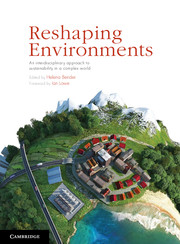Book contents
- Frontmatter
- Contents
- Contributors
- Acknowledgements
- Introduction Reshaping environments – an opportunity for envisioning the future
- Part 1 Cases
- Part 2 Skills
- Part 3 Theory
- 13 Conceptualising change
- 14 Sustainability
- 15 Human needs and norms
- 16 Conceptualising and thinking about environmental systems
- 17 Why scale matters
- Index
- Plate Section
- References
15 - Human needs and norms
some concepts for exploring sustainable human–environment relationships
from Part 3 - Theory
Published online by Cambridge University Press: 05 February 2013
- Frontmatter
- Contents
- Contributors
- Acknowledgements
- Introduction Reshaping environments – an opportunity for envisioning the future
- Part 1 Cases
- Part 2 Skills
- Part 3 Theory
- 13 Conceptualising change
- 14 Sustainability
- 15 Human needs and norms
- 16 Conceptualising and thinking about environmental systems
- 17 Why scale matters
- Index
- Plate Section
- References
Summary
Introduction
This chapter focuses on some human dimensions of human–environment relationships. It will first explore human needs, which play a key role in environmental decision-making. To design or plan a home, an office block, a national park, a town’s water supply or an aeroplane, one must understand human requirements from that environment. Sometimes these must be defined with precision, identifying for example not only how much food, water and shelter is required, but at what locations and points in time. The second concept explored is ‘norms’. Norms can be understood as patterns of behaviour or thought within social groups that tend to create a pressure for people within the group to behave in similar ways. Understanding local and cultural norms can also inform environmental design, planning and management. For example, the landscape architect can identify typical ways people move through an environment – preferred pathways and modes of transport – to help them design a landscape that better fits with local norms for using that space (Cooper and Francis 1998). Urban planners share similar concerns: in Chapter 2 Sun Sheng Han describes how increasing norms for car ownership are being managed in Singapore. Wildlife conservation officers must clarify local norms regarding food, hunting and religious taboos to help them develop effective plans to protect endangered species. Engineers will need to identify typical patterns of behaviour to help them design technologies that are appropriate for local norms. For example, in Chapter 5 Graham Moore explains how the gender-based division of labour in the village of Ilahita was an important consideration in designing an appropriate water supply.
This chapter argues that:
while needs are difficult to define, an understanding of human needs is critical to sustainable environmental planning and policy;
the human need for belonging and identity means that the ways people satisfy their needs will be shaped by social norms;
the ways people satisfy their needs vary significantly and some ‘satisfiers’ may be more successful than others in terms of costs and benefits for individual people, society and the broader environment; and
it is therefore important to make human needs and norms explicit in environmental planning and policy, and to critically evaluate the ways that needs are satisfied.
Information
- Type
- Chapter
- Information
- Reshaping EnvironmentsAn Interdisciplinary Approach to Sustainability in a Complex World, pp. 335 - 351Publisher: Cambridge University PressPrint publication year: 2012
References
Accessibility standard: Unknown
- 1
- Cited by
